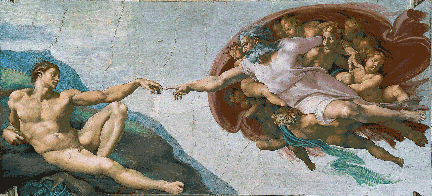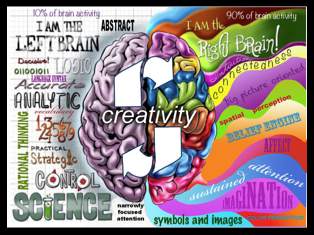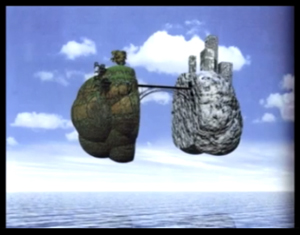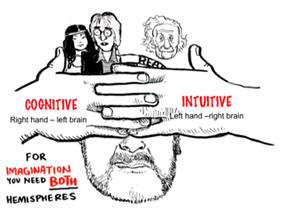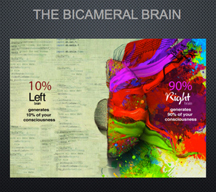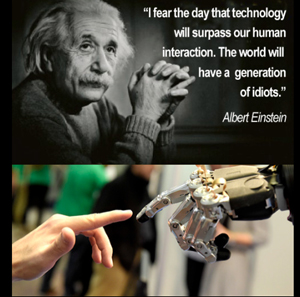 |
|||||||||||||||
 |
|||||||||||||||
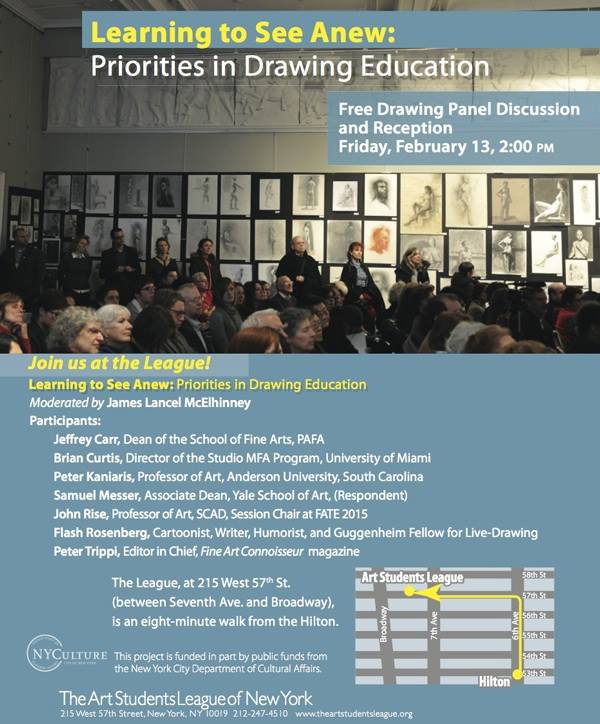 |
|||||||||||||||
|
The Primacy of Perception While preparing a paper on the topic of the art/science intersection known as Neuroaesthetics I discovered that currently this multi-disciplinary intersection is based upon blatantly sophomoric definitions of art, on an inappropriately reductionist understanding of human consciousness, and on clumsy and outdated scientific models. But the failures of Neuroaesthetics are not what I have come to discuss today. I am here to talk about the importance of perceptual drawing. Though Neuroaesthetics proved disappointing my research did lead me, tangentially, to an alternative approach for investigating art’s relationship to complex neural functionality that is both more intriguing and intuitively satisfying – namely, the functional differentiation of the bi-cameral brain. I am here to propose that an understanding of the differentiated functionality of the bi-cameral brain provides a uniquely effective entry point for discussing the inherent value of hands-on training in perceptual drawing.
There has long been considerable evidence to support the proposition that the bi-cameral structure of the human brain is functionally significant in ways that meaningfully shape human lives but it is only relatively recently that we have come to understand that the functional difference between the hemispheres is not in what each hemisphere does but it is in how each hemisphere attends to the world. While we have one brain we have two minds – each capable of sustaining consciousness – each providing distinct types of attention – and each with distinct sets of sensations, values, and personality.
It is the integration of these starkly contrasting styles of awareness that makes us who we are. Our experience of ‘self’ is derived from a combination of a broad, open, intuitive, vigilant, alert, fluid, sustained, embodied, subjective awareness located in the right hemisphere and of a virtual, fragmented, de-contextualized, narrowly focused, detail oriented, self-reflective, concept-oriented attention style in the left. It has been established that it is the right brain that provides direct and immediate engagement with the world through our bodily senses while the left-brain provides us the equally important ability to distance ourselves from direct experience by re-presenting, abstracting our bodily perceptions into rational, cognitive thoughts. It is theorized that being able to balance these two different modes of attention provides humans a distinct evolutionary advantage. It has also been determined that while the left-brain has traditionally been labeled the ‘dominant’ hemisphere because its language processing ability supplies our conscious idea of ‘self,’ the fact is that more than 90% of our brain’s awareness is non-verbal. This means that despite the tendency for language-based cognition to describe the ‘self’ that is inside our head, it is actually our empathetic, intuitive right brain processing of our embodied perceptions that provides the majority of our awareness of the ‘self’ and its relation to the phenomenal world. This direct, empathetic encounter with the phenomenal world constitutes the ‘primary consciousness’ of our being. Or as Descartes should have said, “I feel therefore I am.
Acknowledging the primacy of perception in no way diminishes the importance of analytical thinking. The left-brain analytical style of attention is essential for us to be fully functional and emotionally whole human beings. As anyone who has met an individual with catastrophic damage to either hemisphere can attest, such damage brings about pathological disruptions in behavior that markedly compromise quality of life. For a dramatic book about just how drastically consciousness is transformed when one hemisphere is taken off line I refer you to Dr. Jill Bolte Taylor’s moving first-person account of living through a massive left-hemispheric cerebral hemorrhage titled A Stroke of Insight. More intriguing still is Iain McGilchrist take on a related subject. McGilchrist, a former poetry professor at Oxford and now a practicing psychiatrist and professor of Psychiatry at Oxford, has written a remarkably innovative and thought provoking book, The Master and His Emissary, that uses the behavioral pathologies displayed by patients with lateral brain damage as a metaphoric starting point from which he hypothesizes that cultures that rely excessively on the information processing style of just one hemisphere should exhibit symptoms of pathologically disrupted functionality similar to that exhibited by individuals with lateral brain damage. McGilchrist begins his analysis by compiling an impressively encyclopedic survey of neuro-anatomy, neuropathology, psychology, philosophy, poetry, theater, religion, history, music, science, technology, and visual art spanning twenty-five hundred years of Western culture from pre-Socratic 6th century Greece up through and including the Postmodern period. To determine each culture’s relative bi-cameral balance McGilchrist evaluates how each culture address the four primary sources of emotional well-being – nature, the spiritual impulse, the human body, and art and concludes that only a small handful of Western cultures have succeeded in maintaining a stylistically balanced approach in attending to the world while most appear, to varying degrees, pathologically weighted toward virtual, atomized, abstract, narrowly focused styles of left-brain analytical thinking.
As some of you might have already anticipated, when McGilchrist evaluates the scientific materialist character of contemporary postmodern culture, he concludes that it embodies an all-time historic low-point in balanced bi-cameral functioning. For those, like myself, who find his speculative analysis both instructive and enlightening there is considerable cause for alarm about the health and well being of our culture. While science and technology are both useful and powerful tools they represent only a small portion of the mental toolkit we need to be fulfilled as creative human beings. And it is not only those involved in the arts and humanities who understand this. Just this past December in an interview with BBC Stephen Hawking joined a growing chorus of concerned scientists in issuing a sharply worded warning cautioning his fellow scientists and the world at large that the creation of an unbridled, exponential expansion of digitized left-brain intelligence could result in cataclysmic challenges to human survival.
If the intuitions of the likes of McGilchrist and Hawking are on target we appear to be rushing headlong into a technological future that leaves little room for our humanity. Symptoms of the imbalance abound. Nature is stripped of metaphoric meaning and treated simply as an exploitable resource. Working with one’s hands and directly engaging the phenomenal world is devalued and replaced by organizational planning and virtual reality. Regulatory bureaucracy replaces common sense and data masquerades as knowledge. Technology expands exponentially and privacy rights are obliterated. The arts and humanities are dismissed as intellectual curiosities. Exploitation replaces cooperation in social relationships and the accumulation of individual wealth trumps the importance of social cohesion. Success in the marketplace takes over as the prime arbiter of social values. Intimacy is displaced by pornography as nausea and boredom compel us toward novelty and spectacle. Morality falls victim to utilitarian calculation based in self-interest while our higher values are ironized and deconstructed into irrelevancy.
This pervasive imbalance that permeates our culture goes a long way in explaining why Neuroaesthetics gets so little pushback when it so presumptuously overstep its bounds and substitutes static, sterile data for the fluidity and profundity of perceptual experience. In such a world representational art images are deprived of their metaphorical power to connect us to the phenomenal world but it does not have to be this way. As artists, art lovers, and art historians, as trusted protectors of empathetic engagement with the phenomenal world, it is our privilege to recognize and promote the pivotal restorative importance of perceptual drawing by celebrating teachers and students, like those of this revered institution, for their unwavering commitment to skill acquisition through hard-earned, painstaking, hands-on training in perceptual studio practice. Encourage your students to feel. Teach them to care. Provide them the tools to meaningfully respond to things that are beautiful and alive in their perceptual experience secure in the knowledge that developing intuitive understanding through the pursuit of excellence in our direct encounters with the physical world provides the means to heighten and make more significant our personal and collective experience.
|
|||||||||||||||
| PRESENTATION INDEX | SITE INDEX | ||||||||||||||
| email: brian_curtis@mac.com | |||||||||||||||
| University of Miami Faculty Webpage | |||||||||||||||
| last updated 07/16/2018 | |||||||||||||||
